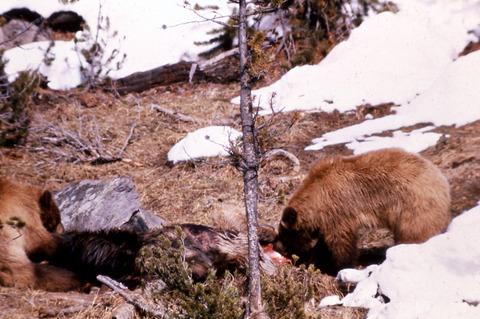The last time I saw a grizzly in Yellowstone National Park, back in September, it was more interested in grubs, tubers and forbs than it was in me, fortunately. But that was last fall, when the park's bears were just topping off their nutritional needs. Now they're coming out of hibernation and they're really hungry.
So, not surprisingly, the folks at Yellowstone want you to be careful if you're out and about in the park these days. Tracks from an undetermined species of bear were spotted March 1 on Specimen Ridge, and tracks from a grizzly were spotted on March 3 along the Tower Fall ski trail.
These bears weren't sight-seeing. They were shopping for groceries. And, not surprisingly, they're particularly attracted to elk and bison that have died over the winter. Indeed, elk and
bison carcasses are such a prized source of food that bears will aggressively defend these buffets. Anyone disturbing a bear feeding on a carcass puts themselves at serious risk for injury.
Park regulations require you to stay 100 yards from black and grizzly bears at all times. The best defense is to stay a safe distance from bears and use your binoculars, telescope, or telephoto lens to get a closer look. Hikers, snowshoers, and cross-country skiers are encouraged to travel in groups of three or more, make noise on the trail, and keep an eye out for bears.
Bear pepper spray has proven to be a good last line of defense if you keep it handy and use it according to directions when the bear is within 30 to 40 feet.
Yellowstone has several seasonal Bear Management Area closures designed to reduce encounters with bears in areas that have a high density of elk and bison carcasses. These closures help prevent human/bear conflicts and provide areas where bears can roam free from human disturbance.
With that in mind, the following areas are closed to humans through May 22:
* Firehole Lake Drive
* the Fountain Paint Pot Nature Trail, boardwalk and parking area;
* and the Midway Geyser Basin boardwalk and parking area.
Beyond that, if you're hiking, skiing, or snowshoeing in the park for the next couple months, check at park visitor centers or the park website for dates and locations of other bear closure areas.
Lastly, visitors are also reminded to keep food, garbage, barbecue grills and other attractants stored in hard-sided vehicles or bear-proof food storage boxes. This helps keep bears from becoming conditioned to human foods, and helps keep park visitors and their property safe.
Bear sightings also should be reported to the nearest visitor center or ranger station as soon as possible.


 Support Essential Coverage of Essential Places
Support Essential Coverage of Essential Places






